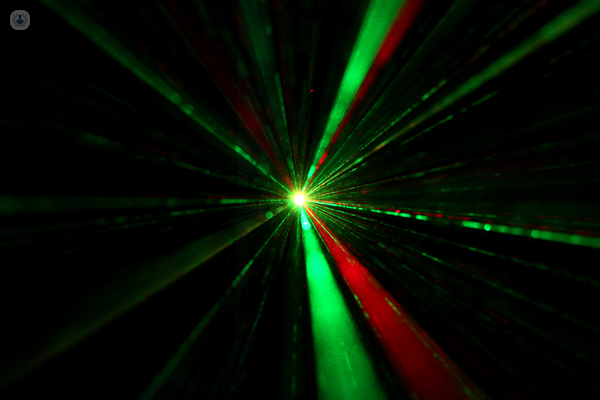
What is laser lithotripsy?
Laser lithotripsy is a surgical technique to remove kidney stones, using a laser to destroy them, with the holmium laser being perhaps the most famous device used. It is an example of minimally invasive laser technology.
It is usually performed under local anaesthesia or light sedation to eliminate the pain of the intervention.
Why is laser lithotripsy done?
Laser lithotripsy is used to fragment kidney stones that are too large to be passed out of the body in the urine. It is an alternative to extracorporeal shockwave lithotripsy, which uses sound waves from outside the body to break down the stones. However, this technique has limitations, and may be ineffective due to the size, position, or hardness of the stone. Laser lithotripsy is generally effective regardless of these factors.
What does laser lithotripsy consist of?
The urologist first locates the stone by passing a scope into the urinary tract via the urethra. A flexible laser fibre is inserted through the scope in order to deliver the laser pulse directly to the stone. The energy from this fragments the stone into pieces small enough to pass out in the urine.
Preparation for laser lithotripsy
Before laser lithotripsy, the patient should inform the doctor:
- If they are or could be pregnant
- Any medication they are taking
During the day of the procedure, the patient will probably be advised not to drink or eat anything for several hours beforehand.
Care after laser lithotripsy
The fact that an endoscopic instrument is inserted into the urinary tract can cause inflammation, which can, in turn, hinder the passage of urine from the kidney to the bladder and can cause a burning sensation when urinating. This feeling should go away within a day or so. There may also be slight bleeding in the urine in some cases, which should not last for more than 5 days.
Sometimes, the doctor may place a small tube called a stent inside the ureter (one of the tubes that connects the kidney to the bladder) to hold it open while the stone fragments pass through.
Antibiotics may be prescribed to prevent an infection. Always follow the doctor’s instructions as to what medication should be taken following an operation.
03-04-2013 06-05-2023Laser lithotripsy
Professor Francis Chinegwundoh MBE - Urology
Created on: 03-04-2013
Updated on: 06-05-2023
Edited by: Aoife Maguire

What is laser lithotripsy?
Laser lithotripsy is a surgical technique to remove kidney stones, using a laser to destroy them, with the holmium laser being perhaps the most famous device used. It is an example of minimally invasive laser technology.
It is usually performed under local anaesthesia or light sedation to eliminate the pain of the intervention.
Why is laser lithotripsy done?
Laser lithotripsy is used to fragment kidney stones that are too large to be passed out of the body in the urine. It is an alternative to extracorporeal shockwave lithotripsy, which uses sound waves from outside the body to break down the stones. However, this technique has limitations, and may be ineffective due to the size, position, or hardness of the stone. Laser lithotripsy is generally effective regardless of these factors.
What does laser lithotripsy consist of?
The urologist first locates the stone by passing a scope into the urinary tract via the urethra. A flexible laser fibre is inserted through the scope in order to deliver the laser pulse directly to the stone. The energy from this fragments the stone into pieces small enough to pass out in the urine.
Preparation for laser lithotripsy
Before laser lithotripsy, the patient should inform the doctor:
- If they are or could be pregnant
- Any medication they are taking
During the day of the procedure, the patient will probably be advised not to drink or eat anything for several hours beforehand.
Care after laser lithotripsy
The fact that an endoscopic instrument is inserted into the urinary tract can cause inflammation, which can, in turn, hinder the passage of urine from the kidney to the bladder and can cause a burning sensation when urinating. This feeling should go away within a day or so. There may also be slight bleeding in the urine in some cases, which should not last for more than 5 days.
Sometimes, the doctor may place a small tube called a stent inside the ureter (one of the tubes that connects the kidney to the bladder) to hold it open while the stone fragments pass through.
Antibiotics may be prescribed to prevent an infection. Always follow the doctor’s instructions as to what medication should be taken following an operation.


Ask an expert: Can the occasional tipple cause kidney stones?
By Mr Anthony Blacker
2025-02-05
Maintaining good hydration by drinking plenty of water is the best way to avoid kidney stones but how do other drinks such as beer, wine or fruit juice affect this? Highly respected consultant urologist Mr Anthony Blacker expertly explains how different drinks impact the production of kidney stones and how the condition is treated in this illuminating article. See more


Ask an expert: How does laser lithotripsy work?
By Mr Keng Jin Ng
2025-02-03
Leading consultant urological surgeon Mr Keng Jin Ng explains the benefits of laser lithotripsy and what to expect both from the procedure itself and the recovery period to follow in this informative article. See more


Managing kidney stones: How effective is laser lithotripsy?
By Mr Aasem M Chaudry
2025-02-01
Leading consultant urologist Mr Aasem Chaudry gives an expert guide to laser lithotripsy for kidney stones including how it works and who is a good candidate in this informative article. See more
Experts in Laser lithotripsy
-
Mr Keng Jin Ng
UrologyExpert in:
- Laser lithotripsy
- Cystitis
- Urinary incontinence in women
- Female urology
- Prostatitis
- Prostate cancer
-
Mr Andrew Ballaro
UrologyExpert in:
- Adult circumcision
- Benign prostate enlargement
- Laser lithotripsy
- Prostate
- Kidney stones
- Holmium laser (HoLEP)
-
Mr Kasra Saeb-Parsy
UrologyExpert in:
- Pelvic pain syndrome
- Prostate biopsy
- Laser lithotripsy
- Benign prostate enlargement
- Prostate cancer
- Prostate Laser
-
Mr Aasem M Chaudry
UrologyExpert in:
- Benign prostate enlargement
- Prostate cancer
- Kidney stones
- Laser lithotripsy
- Laparoscopy
- Urologic Oncology
-
Ms Johanna Thomas
UrologyExpert in:
- Paediatric urology
- Undescended testicle (Cryptorchidism)
- Foreskin problems
- Urinary tract infection
- Laser lithotripsy
- Kidney stones
- See all

The Outpatients and Diagnostic Centre at 30 Devonshire Street (HCA)
The Outpatients and Diagnostic Centre at 30 Devonshire Street (HCA)
30 Devonshire St, London W1G 6PU
No existe teléfono en el centro.
By using the telephone number provided by TOP DOCTORS, you automatically agree to let us use your phone number for statistical and commercial purposes. For further information, read our Privacy Policy
Top Doctors

The Manor Hospital - part of Circle Health Group
The Manor Hospital - part of Circle Health Group
Church End, Biddenham, Bedford MK40 4AW
No existe teléfono en el centro.
By using the telephone number provided by TOP DOCTORS, you automatically agree to let us use your phone number for statistical and commercial purposes. For further information, read our Privacy Policy
Top Doctors

The Priory Hospital - part of Circle Health Group
The Priory Hospital - part of Circle Health Group
Priory Road, Edgbaston, Birmingham B5 7UG
No existe teléfono en el centro.
By using the telephone number provided by TOP DOCTORS, you automatically agree to let us use your phone number for statistical and commercial purposes. For further information, read our Privacy Policy
Top Doctors
-
The Outpatients and Diagnostic Centre at 30 Devonshire Street (HCA)
30 Devonshire St, London W1G 6PU, Central LondonExpert in:
- Orthopaedic surgery
- Orthopaedic spinal surgery
- Musculoskeletal pain
- Musculoskeletal ultrasound
- Spinal stenosis
- Spinal injections
-
The Manor Hospital - part of Circle Health Group
Church End, Biddenham, Bedford MK40 4AW, BedfordExpert in:
- General Surgery
- Orthopaedic surgery
- Physiotherapy
- Obstetrics and Gynaecology
- General practice
- Urology
-
The Priory Hospital - part of Circle Health Group
Priory Road, Edgbaston, Birmingham B5 7UG, EdgbastonExpert in:
- Cancer
- General Surgery
- Orthopaedic surgery
- Thoracic Surgery
- Obstetrics and Gynaecology
- Urology
- Most viewed diseases, medical tests, and treatments
- Fertility preservation
- Female infertility
- Undescended testicle (Cryptorchidism)
- Testicular ultrasound
- Minimal access surgery (keyhole surgery)
- NanoKnife
- Vaginal dryness
- Pelvic pain syndrome
- Kidney stones
- Medicolegal








